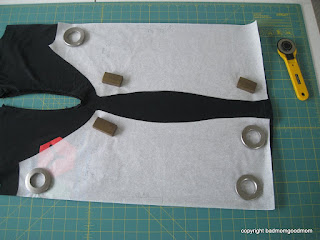I've been making dresses, often from recycled clothing. You've seen some of these before, notably the
what would Rachel wear? dress on the far right.

The blue tie-dye rayon dress is the pieced bodice of
Burda 8985 V2.

I've made shirtdresses from scratch before, like this rayon number from a 1980s Ralph Lauren pattern. (You can see a full length photo of the dress on me in
Two Scarves. ) I was not happy with the waist seam construction and looking for a better way. Click on this photo to see the words on the print. Laying out the dress so that "look here" does not appear on potentially embarrassing locations took a great deal of time. LOL.
However, the dress was well loved and worn often for about a decade. I wanted to replace it with another blue shirtdress without construction drama.
The Burda 8985 method of sewing a 1" wide straight seam, finishing the edges, then topstitching the seam allowance to the bodice with some elastic inside is certainly much easier and faster. It can be bulky in a heavier fabric. But, in a light one, it yields good results.
I came across this blue men's shirt at Goodwill, with a ketchup stain on one sleeve. I chopped off the lower sleeves with the stain about 6" below the underarm seam. Then I chopped off the bodice about 18" below the back neck like this. (I have a 15.5" back waist, the seam allowance takes up 1", and that leaves 1.5" for blousing and movement ease.)
I find it funny that I am replacing a Ralph Lauren dress with one made from a Ralph Lauren Polo shirt. I then attached a cotton jersey skirt from a Calvin Klein skirt pattern.
I found a plum men's shirt at Goodwill in a cotton/nylon blend with slight underarm staining. You can't see it unless you look really close and I am not averse to elbowing people who stick their faces into my armpit. So the shirt was perfect for this plum printed lawn remnant I picked up at SAS. Any clue what I am doing in this photo?
I was short of fabric, so I pieced the back with a brown/orange lawn piece found in the same bin. ($6/lb and cotton lawn weighs next to nothing. There is a sewn in poly lining, $4/lb and even more weightless than the lawn.)
There was just enough of the brown/orange lawn to make a second shirtdress with this coral shirt languishing unworn in my closet.
It was perfect for our hostess in Colorado.
The eagle-eyed may notice other unblogged dresses on the rod, including one made with a
vintage Issey Miyake pattern. Stay tuned!


































